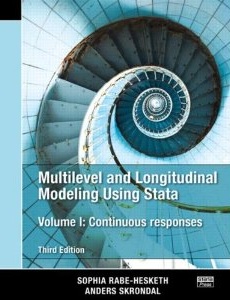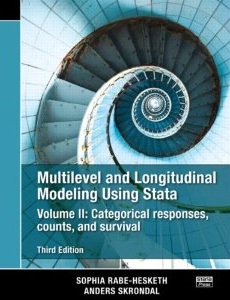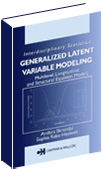What's New
Since 15 July 2012
Frequently asked questions (FAQs) has been added (work in progress).
Since 22 March 2012
Our book is out!
Volume II of the book demonstrates and explains how gllamm
(and Stata's official commands where applicable)
can be used to estimate models for all sorts of response types: Binary, ordinal,
and nominal responses or discrete choice, counts, discrete-time survival or durations, and continuous-time survival
Volume I of the book does not use gllamm. To find out how to fit most
of the models from Volume I using gllamm, download:
Since 7 September 2011
By downloading some additional files, gllamm can now be used with Bayesian priors
for variance parameters.
There was a bug in gllapred with the ustd
option for models with several random effects at the same level. This
has been fixed.
Levels of confidence can now be non-integer percentages, e.g.,
level(99.5)
Since 15 September 2010
gllamm previously did not exponentiate all
coefficients in multinomial logit models with the eform
option and this has been fixed.
There was a bug when attempting to estimate models with 10 or more
random effects or latent variables and this has been fixed.
gllamm no longer works in Stata version 6
(Stata 7 was released in December 2000 and the current version
is Stata 11.1).
The init option, which sets the random part
of the model (apart from the level-1 error, if applicable) to zero, did not
behave correctly when there was nothing to estimate, or when
it was used together with the from() option.
These bugs have been fixed. When the init option
is used with the trace option,
the "General model information"
output now states which parameters will not estimated.
Since 15 September 2008
gllapred with the fsample option
now computes empirical Bayes predictions of
random effects (u option),
posterior mean probabilities (mu option), and
posterior means of the linear predictor (linpred option)
for observations where the response variable is missing. Predictions of random effects
are also given if any of the explanatory variables are missing.
See
slides, do-file and data for 2008 UK Stata Users Group Meeting.
gllamm previously did not show the estimated
threshholds or cut-point parameters for ordinal logit models
when the eform option was used. This
has been fixed for Stata versions 8, 9, and 10. For
earlier versions, display the threshholds after estimation
using the command: gllamm (no variables or options).
Since 30 January 2008
Our book is out!
|
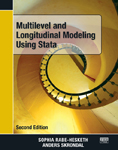 |
|
Rabe-Hesketh, S. and Skrondal, A. (2008). Multilevel
and Longitudinal Modeling using Stata (Second Edition). College Station, TX: Stata Press.
Datasets for the book
|
Since 30 December 2007
Review of latent variable modeling was published:
Skrondal, A. and Rabe-Hesketh, S.(2007).
Latent variable modelling: A survey.
Scandinavian Journal of Statistics 34, 712-745.
Local
Since 11 November 2006
gllapred now calculates posterior correlations
of random effects or latent variables - see corr
option.
gllamm previously did not produce correct
robust standard errors with the init and
weight() options if there were weights different
from 1 at levels 2 or above. This has been fixed.
gllamm previously did not accept the
ip(g) option, but now it does.
gllamm previously did not exclude observations
from the estimation sample where the variables specified in
the expanded() option were missing. Now it does.
The command gllamm, robust previously did not
work if the previous gllamm command specified
several ordinal links. This has been fixed.
Since 18 July 2006
gllapred produced incorrect predicted marginal probabilities
for three-level or higher-level models (with the mu
and marg options), and this has been fixed.
Thanks to Ann Berrington for pointing
this out.
Since 23 May 2006
gllamm previously ignored the exposure() option
and now produces a proper error message and stops (offset()
should be used instead). Thanks to Dale Needham
for pointing this out.
The eval option
now works when combined with the pweight() option.
gllamm now prints a warning when non-integer frequency
weights are used.
Since 14 April 2006
Stata/MP, a parallel version of Stata
that runs simultaneously on several processors, has been released. On
a dual core or dual processor machine, gllamm will
run up to twice as fast depending on the problem - see Appendix E
of the Stata/MP Performance Report
for some preliminary results for gllamm.
Since 18 March 2006
The gllamm wrapper ssm
has been updated to correct the way standard errors are calculated for some
of the parameters.
Since 13 March 2006
A review of gllamm has been
written by Leonardo Grilli and Carla Rampichini
Since 27 February 2006
A solutions manual (172 pages) and do-files for all exercises in
Multilevel and Longitudinal Modeling Using Stata
are now available for instructors. See:
http://www.stata.com/bookstore/mlmus.html
Since 8 December 2005
New gllamm wrapper ssm
for endogenous switching and sample selection models for
binary, count, and ordinal variables. Written by Alfonso Miranda and Sophia Rabe-Hesketh.
Since 19 October 2005
Bugs that occurred in gllamm with the
eval and robust options
have been fixed.
Since 10 August 2005
Our book is out!
|
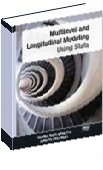 |
|
Rabe-Hesketh, S. and Skrondal, A. (2005). Multilevel
and Longitudinal Modeling using Stata.. College Station, TX: Stata Press.
Datasets for the book
|
Since 3 February 2005
Worked example added for Explanatory Item Response Models by De Boeck and Wilson (Eds.)
Since 5 January 2005
There was a bug in gllamm with any or all of the options
robust, cluster()
and pweight()
that caused gllamm to repeatedly print a red error message.
This problem has been fixed.
Since 26 October 2004
The GLLAMM manual has been updated.
Since 21 October 2004
gllapred previously didn't work with the mu
option for models with more than two levels. Thanks to Phil Schumm for
reporting this bug. This has now been fixed.
gllapred with options xb
and nooffset did not work correctly and this
has been fixed.
Since 6 October 2004
Thanks to Bobby Gutierrez and Stata Corporation,
gllamm (updated 6 October 2004)
is now faster for certain
kinds of models in Stata 8.2
(updated on or after 6 October 2004).
Specifically, gllamm is faster for
models with composite links and latent class models where
probabilities of latent class membership depend on covariates.
Since September 2004
Composite links now available in gllamm, see
here for gllamm
commands and output for classic blood types example
and here for the paper:
Generalized Linear Latent and Mixed Models
with Composite Links and Exploded Likelihoods. Proceedings
of the 19th International Workshop on Statistical Modeling
(Editors A. Biggeri, E. Dreassi, C. Lagazio and M. Marchi),
Florence, Italy, pp. 27-39.
gllamm now prints out the iteration log from iteration
0 when adaptive quadrature is used (instead of from iteration 1).
The wrapper cme for covariate measurement error models
now collapses the data if several units have the same values on all the
relevant variables. As kindly pointed out by Hendrik Juerges, a bug in the
previous version prevented this from happening.
Some more worked examples have been added here.
Since May 2004
Our book is out!
Some worked examples and do-file have been added here
Since April 2004
The sample size saved in
e(N) is now the number of level-1 units
instead of the number of top-level units.
gllamm now produces an error message if
an invalid ip() is specified instead of
assuming the default.
gllapred now works for mixed responses if
some responses are unordered categorical
(mlogit link).
Since February 2004
New courses announced
New iterate(#) option in gllamm to
run gllamm no more than a given number of iterations
even if convergence is not reached.
gllamm now produces a proper error message if
any of the variables in the i() option are
not numeric.
Since September 2003
New URL for gllamm webpages: http://www.gllamm.org
New wrapper cme for gllamm to estimate
generalized linear models with covariate measurement error. See Wrappers.
New nodisplay option to stop gllamm
displaying estimates (useful for wrappers}.
Some bugs in gllamm have been fixed. e.g. the cluster() option
sometimes did not work.
Since June 2003
New cooksd option for gllapred
to compute Cook's distances for top-level units.
New ustd option for gllapred
to obtain approximately standardised empirical Bayes predictions
of the random effects or latent variables (sampling variance
approximated by 'prior variance - posterior variance').
Since January 2003
Thanks to Stata Corporation,
gllamm is now considerably faster in Stata 8
(updated on or after 17 January 2003) than in Stata 7.
Since November 2002
New peqs() option for latent class models
to allow latent class probabilities to depend on covariates.
New pweight() option to specify sampling weights.
This should be used with caution if the sampling weights apply
to units at a lower level than the highest level in the multilevel model.
New cluster() option to obtain robust standard
errors (sandwich estimator) if the highest level units in the
multilevel model are nested in (even higher level) clusters.
Since October 2002
New robust option for gllamm
to obtain the sandwich estimator of the covariance matrix
of the estimated parameters.
New mu option for gllapred
to obtain the expectation of the response (or predicted
probabilities for dichotomous, ordinal or nominal responses). The following variants
are available:
- Conditional expectation given specified values of the latent variables.
This is useful for looking at 'conditional' effects of covariates
for given values of the latent variables.
- Expectation with respect to the posterior distribution of
the latent variables, i.e. conditional on the observed responses.
This provides the 'best' predictions for the units.
- Expectation with respect to the prior distribution of the latent variables.
This is useful for looking at the 'marginal'
or population average effects of covariates.
New pearson, deviance and
anscombe options for gllapred
to obtain 'level 1' residuals, either for specified values of the
latent variables or their posterior expectation.
Since September 2002
New 'post-estimation' command gllasim
for simulating the responses and/or latent variables for
the model just estimated in gllamm:
See programs
New webpages:
New ethresh() option for gllamm.
Like the thresh() option, this option can be used
to specify models for the thresholds in cumulative models for
ordinal data to relax the parallel regression assumption. However, a
different parameterization is used to impose the order restriction on
the thresholds. See worked example for King et al. (2002)
Improved behaviour of gllamm with the init
(initial values) option. Constraints are for example now permitted.
New from() option for gllapred to make
predictions for different parameter values (than those estimated).
Since April 2002
Thanks to Stata Corporation, adaptive quadrature is now considerably faster in Stata 7
if updated since 4 April 2002.
Several options have been added to gllapred including:
if and in
ll to compute the likelihood contributions of the
highest level clusters.
fac to compute predictions of the latent variables
when these are regressed on observed or other latent variables.
The u option in this case provides predictions of
the disturbances.
|
